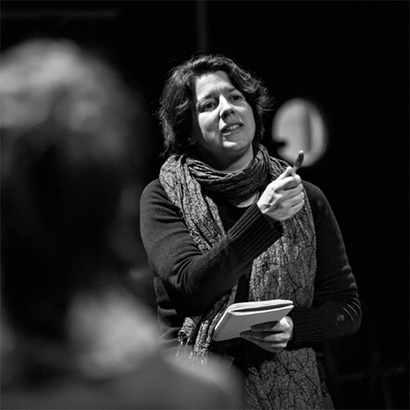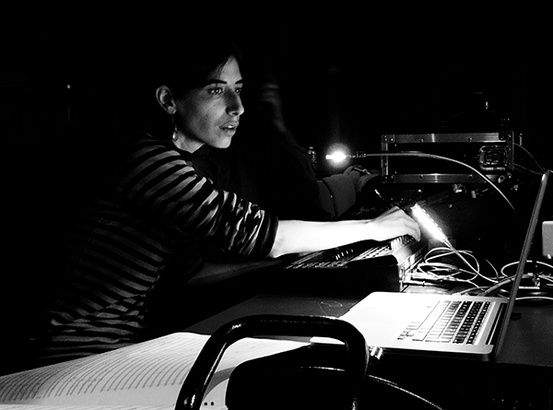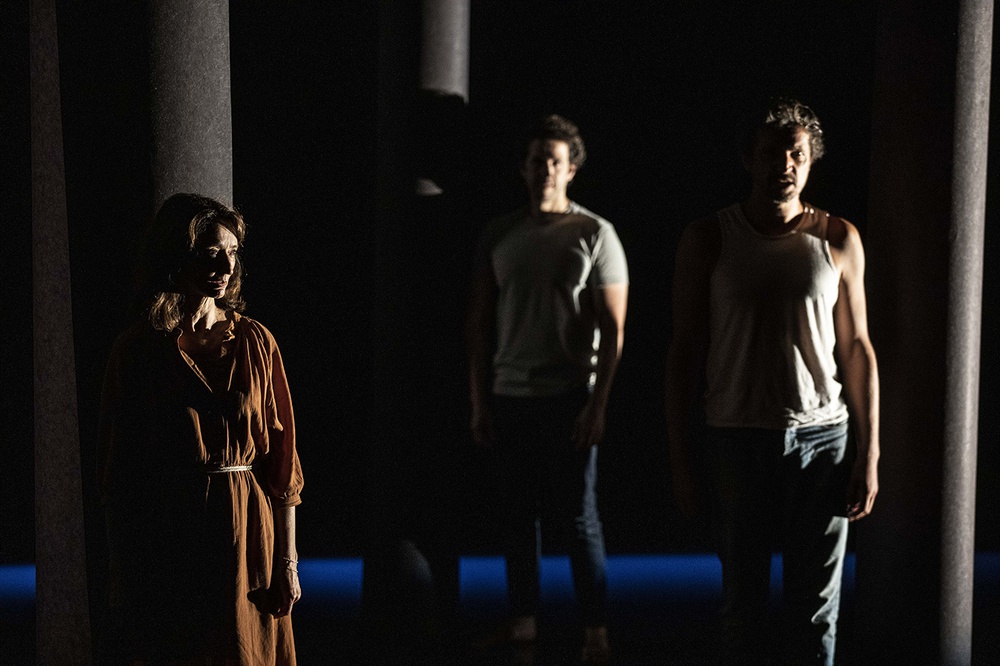C’est un projet bifide dans lequel se sont lancées la metteuse en scène Anne Monfort et la compositrice Núria Giménez-Comas autour de la pièce Nostalgie 2175 d’Anja Hilling : d’une part une production scénique, qui tourne dans toute la France dès janvier 2022, et d’autre part une « Musique-Fiction » destinée à une diffusion Ambisonics. Elles lèvent pour nous le voile sur les différents enjeux, y compris sociétaux et écolos, qui les ont séduites dans le texte de la dramaturge allemande.


De gauche à droite : la metteuse en scène Anne Monfort (© DR) et la compositrice Núria Giménez-Comas (© Christophe Egea)
D’abord et avant tout, comment avez-vous jeté votre dévolu sur Nostalgie 2175 d’Anja Hilling ?
Anne Monfort : Ce sont les traducteurs pour l’édition française du texte, Jean-Claude Berutti et Silvia Berutti-Ronelt, qui me l’ont envoyé, en amont de sa sortie. Je connaissais déjà le travail d’Anja Hilling, et j’ai tout de suite été séduite par la narration très active de Nostalgie 2175, mais aussi par la manière dont la pièce aborde le rapport à l’écologie, à la catastrophe. C’est une autrice qui travaille beaucoup sur le sujet : elle n’écrit que sur des forêts qui brûlent, des jardins qui parlent ou les préoccupations des fleurs, bien plus intéressantes que celles des humains. J’ai rapidement eu envie de monter la pièce au théâtre. Comme j’avais le sentiment que la musique pouvait y apporter une autre dimension dramaturgique, j’ai appelé l’Ircam pour le leur proposer.
Núria Giménez-Comas : Et c’est l’Ircam qui nous a mises en contact. De fait, nous cherchions à ce moment-là, avec Emmanuelle Zoll, un texte susceptible de se prêter à une « Musique-Fiction », et la proposition est tombée à pic. J’ai lu la pièce assez rapidement et j’ai été rapidement convaincue : j’y retrouvais notamment la dimension poétique que je cherchais. J’aimais aussi ce rythme créé par les dialogues, en alternance avec une narration plus intime, et cette complexité qui émerge peu à peu dans les relations entre les personnages. Le caractère dystopique m’a, moi aussi, beaucoup attirée : nous étions alors en plein confinement et ce que je lisais (notamment l’impossibilité de toucher, et de se toucher les uns les autres, qu’impose la chaleur écrasante qui, dans la pièce, règne à la surface terrestre) était très proche de ce qu’on vivait alors.
: Et c’est l’Ircam qui nous a mises en contact. De fait, nous cherchions à ce moment-là, avec Emmanuelle Zoll, un texte susceptible de se prêter à une « Musique-Fiction », et la proposition est tombée à pic. J’ai lu la pièce assez rapidement et j’ai été rapidement convaincue : j’y retrouvais notamment la dimension poétique que je cherchais. J’aimais aussi ce rythme créé par les dialogues, en alternance avec une narration plus intime, et cette complexité qui émerge peu à peu dans les relations entre les personnages. Le caractère dystopique m’a, moi aussi, beaucoup attirée : nous étions alors en plein confinement et ce que je lisais (notamment l’impossibilité de toucher, et de se toucher les uns les autres, qu’impose la chaleur écrasante qui, dans la pièce, règne à la surface terrestre) était très proche de ce qu’on vivait alors.
A.M. : C’est ainsi que nous avons décidé de faire les deux : une mise en scène et une « Musique-Fiction ».
N.G.C. : Les deux formats sont en réalité très différents, notamment par l’approche du traitement du matériau sonore et l’interaction entre son et texte.
A.M. : Par leurs structures et leurs proportions également, sans parler, bien sûr, de l’absence des corps dans la Musique-Fiction, et de leur présence au plateau.
Le discours écologique du texte semble donc avoir joué dans votre choix : à cet égard, le concept « d’artiste engagé » vous semble-t-il pertinent ? S’applique-t-il à vous ?
A.M. : Il fut un temps, pas si lointain, où le théâtre était un peu coincé entre deux extrêmes : les spectacles que l’on pourrait qualifier de « documentaires » d’une part, et les spectacles à vocation esthétique de l’autre, et il était compliqué d’articuler les deux. Pour moi, il est important de parler du réel tout en veillant à la forme : c’est dans cette articulation que mon travail est engagé.
L’esthétique serait ainsi pour vous un détour, qui vous permet d’évoquer des sujets brûlants.
A.M. : Voilà.
N.G.C. : De mon côté, s’agissant de musique, la situation est moins évidente. Cela étant dit, j’ai composé plusieurs pièces, en m’appuyant sur des textes politiques ou engagés. Qu’on le veuille ou non, qu’on soit engagé ou non, ces sujets sont des réalités que l’on vit au quotidien, ce qui en fait des nécessités artistiques. Les aborder n’est pas pour moi un objectif, mais ils infusent nécessairement. Ensuite, cela relève plutôt du vécu, personnel, familial ou sociétal, voire de mémoire historique, qui ensuite se mettent en relation ou cristallisent suite à des trouvailles ou des rencontres, pour se concrétiser en projets artistiques.
Avez-vous le sentiment que ce genre d’œuvres traitant, de près ou de loin, un sujet comme celui-là, sert à quelque chose ?
A.M. : Avec une baisse de fréquentation des salles de 70 %, difficile de l’affirmer ! Cela étant dit, j’ai tendance à considérer que la place de l’action politique est au dehors des enclos artistiques – cela doit être mon côté germanique. L’agit-prop peut servir à éveiller les consciences mais ne doit pas nous dispenser de manifester à la COP 26.
Dans Nostalgie 2175, suite à un désastre, la température sur Terre atteint 60 degrés. Les humains ne peuvent plus vivre sans tenue de protection et les femmes ne peuvent enfanter sans perdre la vie. Considérez-vous cette dystopie comme un conte moral ou un appel à agir ?
A.M. : En réalité, la dystopie n’est que le cadre du drame, comme un arrière-plan. Et cet arrière-plan accueille une histoire d’amour complexe, entre trois personnages. D’ailleurs, l’intrigue se déroule bien après la catastrophe, qui a eu lieu en 2101. Et Anja Hilling fait l’hypothèse que l’humain s’est adapté à la situation. Il a recréé toute la nature de façon artificielle, et a continué à aller de l’avant. C’est ainsi que, par bien des aspects, la pièce n’est pas réellement dystopique : le capitalisme s’y porte très bien, le sexisme aussi… De nombreux détails font écho à notre monde d’aujourd’hui, c’est parfois tout à fait étrange : ces humains de 2175 mènent la même vie que nous, ils sortent dans des bars, vont se baigner dans un lac (même si ça coûte très cher).

© Jean-Louis Fernandez
Enfin, ce qui est passionnant, c’est que, même si l’intrigue se passe en 2175, et si Anja Hilling « prévoit » ce futur, ce n’est pas vraiment de la science-fiction. Ce n’est pas un univers totalement cohérent, un monde clos sur lui-même : la pièce est traversée de percées un peu délirantes, de trouées, qui donnent à rêver et à réfléchir. On y croise par exemple quelques bizarreries : comme cette chaleur extrême, alors même que le soleil a disparu, ou encore ces endroits de nature ruinés, mais beaux, à l’instar du lac dont j’ai parlé plus haut dans lequel nos personnages se baignent – c’est du reste un moment très joyeux dans le texte – : on ne parvient jamais à savoir véritablement si c’est un lac véritable, recréé en intérieur, ou le lac peint un peu plus tôt par l’un des personnages, qui est peintre.
N.G.C. : Très vite le discours doctrinal disparaît et la relation entre les personnages devient le point central. Par ailleurs, ces moments concrets, quotidiens, ces phrases inattendues ou surprenantes, ainsi que les références que le texte fait à des films d’aujourd’hui permettent de nous extraire, par moments, de la gravité de l’histoire.
A.M. : Anja Hilling imagine en effet que, en 2175, tout ce qui reste du passé, ce sont 420 cassettes VHS qui ont survécu au désastre. Toute la fin de la pièce est donc imprégnée par des scènes de films de toute sorte. C’est ainsi que la fiction, dans tout ce qu’elle a de plus « cinéma », reprend le dessus.
N.G.C. : Je me suis emparée musicalement de ces références filmiques, qui donnent bien sûr un côté plus « léger », moins dramatique, à la partie sonore et musicale. Je fais référence à plusieurs de ces films, comme My Own Private Idaho, le Grand Bleu, Dirty Dancing ou Plein Soleil, en jouant avec de petites touches aux couleurs musicales très connotées. J’y ajoute aussi des fragments de ma pièce d’orchestre Nostalgia for light, écrite juste avant, que j’ai évidemment transformés et mis en l’espace, pour apporter aussi un côté « romantique » aux descriptions un peu « Renaissance » des tableaux qui viennent des films.
Comment parvenir à prendre sa liberté dramaturgique vis-à-vis d’un discours qui pourrait paraître par trop sentencieux ?
A.M. : Dans la pièce, la catastrophe n’est plus une menace puisqu’elle est déjà survenue. Le texte même nous aide donc à éviter tout ton moralisateur.
Comment, dès lors, rendre cette pièce à l’anticipation ? Plus largement, quelle « anticipation » pour le théâtre d’aujourd’hui ?
A.M. : Lors de nos premières répétitions au plateau, j’ai pu constater la manière dont le texte résonne : on se rend compte du côté drolatique de cette hypothèse de science-fiction. On a le sentiment que ce sont les acteurs qui sont en train de s’inventer ce monde complètement cinglé. Sans rien faire, on est déjà précipité au lieu même de la magie de l’invention.
N.G.C. : De mon côté, le fait que les êtres humains se soient adaptés en recréant tout de manière artificielle m’a donné l’idée de recréer tous les sons naturels au moyen de différents types de synthèse et d’élaborer ainsi des paysages sonores synthétiques et enveloppants, en trois dimensions.
De même, comment évoquer musicalement la chaleur ou l’impossibilité de toucher en musique ?
N.G.C. : Par le passé, j’ai déjà travaillé sur l’évocation sonore d’une lumière. Au début de la pièce, j’ai ainsi créé l’idée sonore d’une très forte lumière, par l’explosion d’un spectre suraiguë, avec notamment une accumulation de crotales dans l’espace, de bourdonnements, etc.
Pour le toucher, je me suis plutôt intéressée à des frottements dans l’espace. Des frottements de différentes rugosités, à des vitesses variables, que j’ai transformés et parfois complètement tordus, au point de les rendre presque désagréables.
Propos recueillis par Jérémie Szpirglas



